Translation and Meaning of: 節 - setsu
The Japanese word 節[せつ] is a versatile term that appears in various contexts, from everyday conversations to more formal expressions. If you are studying Japanese or simply curious about the meaning and usage of this word, this article will explore its origin, translation, and practical applications. Moreover, we will understand how it is perceived in Japanese culture and what the best ways to memorize it are.
In the Suki Nihongo dictionary, you will find detailed explanations about terms like 節, but here we go beyond the basic definition. Let's dive into real examples, linguistic curiosities, and even tips to avoid confusing this word with other similar ones. Whether to expand your vocabulary or to satisfy your curiosity, keep reading to discover everything about せつ.
Meaning and translation of 節[せつ]
The term 節[せつ] has multiple meanings, depending on the context in which it is used. One of the most common translations is "node" or "joint," referring to parts that connect elements, such as in joints of bamboo or bones. However, it can also mean "economy" or "moderation," especially when associated with expressions like 節約 (setsuyaku), which indicates saving resources.
Another interesting use appears in words like 季節 (kisetsu), which means "season of the year." Here, 節 contributes to the idea of division or specific period. This variety of meanings shows how a single kanji can encompass seemingly distinct concepts that share an idea of segmentation or control.
Origin and writing of the kanji 節
The kanji 節 is composed of the radical for bamboo (竹) and the component 即, which suggests an immediate connection or adjustment. This combination reflects well the meaning of "knot" or "point of connection," as bamboo has natural joints in its stalk. Historically, this character was used to describe divisions in physical objects, but its meaning has expanded to include abstract ideas, such as moderation and periods of time.
It is worth noting that 節 also has an alternative reading, ふし (fushi), which appears in words like 音節 (onsetsu – syllable) or 関節 (kansetsu – joint of the body). This duality of readings is common in kanjis, and understanding when to use each of them is essential for mastering Japanese.
Cultural usage and frequency in the Japanese language
In Japan, 節 is a word that carries important values, especially when related to moderation and economy. Expressions like 節電 (setsuden – energy conservation) and 節水 (setsusui – water conservation) are often used in public campaigns, emphasizing the importance of conscious consumption. This cultural aspect causes the term to frequently appear in news and discussions about sustainability.
Moreover, 節 is also present in proverbs and popular sayings. An example is 節を曲げず (setsu o magezu), which means "not bending one's principles," illustrating how the word can convey notions of integrity and firmness. Whether in everyday life or in more philosophical contexts, 節 remains a relevant and nuanced term.
Vocabulary
Expand your vocabulary with related words:
Synonyms and similar words
- 季節 (kisetsu) - season
- 節日 (setsujitsu) - Holiday or festive day (related to commemorative dates)
- 節目 (semmat) - Milestone, transition point, or significant celebration
- 節度 (setsudo) - Moderation, self-control
- 節制 (sessai) - Self-assessment or control over intensity
- 節約 (setsuyaku) - Economy, savings, reduce expenses
- 節点 (setsuten) - Junction point, node (in technical contexts)
- 節電 (setsuden) - Electricity savings
- 節分 (setsubun) - Festival that marks the beginning of spring (throwing beans to drive away demons)
- 節気 (setuki) - Seasonal period, seasonal climates
- 節制する (sessai suru) - Practice moderation or self-control
- 節約する (setsuyaku suru) - Make savings or saving
- 節電する (setsuden suru) - Practice electricity saving
- 節度ある (setsudo aru) - To have moderation, to have self-control.
- 節点に立つ (setsuten ni tatsu) - Take a position at a junction point
- 節分祭 (setsubun-sai) - Setsubun Festival, celebration of the event
- 節目を迎える (fushime o mukaeru) - Reach a milestone or turning point
Romaji: setsu
Kana: せつ
Type: noun
L: jlpt-n3
Translation / Meaning: at the; section; occasion; time
Meaning in English: node;section;occasion;time
Definition: Grammatical term. The smallest component that makes up a sentence.
Quick Access
- Vocabulary
- Writing
- Sentences
How to Write in Japanese - (節) setsu
See below a step-by-step guide on how to write the word by hand in Japanese. (節) setsu:
Example Sentences - (節) setsu
See below some example sentences:
Chōsetsu suru koto ga taisetsu desu
It is important to adjust.
- 調節する - adjust, regulate
- こと - noun indicating action or event
- が - Particle that marks the subject of the sentence
- 大切 - important, essential
- です - verb to be in the present, indicating courtesy or formality
Other Words of this Type: noun
See other words from our dictionary that are also: noun

